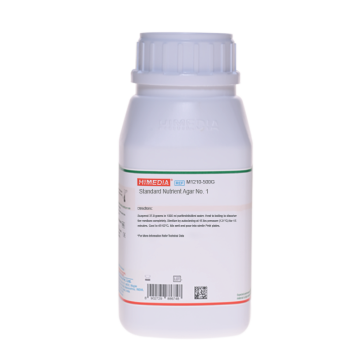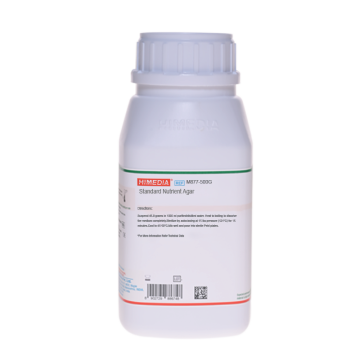 Your enquiry has been submitted
Your enquiry has been submitted
Standard Nutrient Agar No. 2
Standard Nutrient Agar No. 2 is recommended for the cultivation and enrichment of less fastidious bacteria. It can be used in detection of inhibitors in bacteriological examination of meat.
Composition**
| Ingredients | Gms / Litre |
|---|---|
| Meat peptone | 3.450 |
| Casein enzymic hydrolysate | 3.450 |
| Sodium chloride | 5.100 |
| Agar | 13.000 |
Final pH ( at 25°C): 7.5±0.2
**Formula adjusted, standardized to suit performance parameters
Directions
Suspend 25 grams in 1000 ml distilled water. Heat to boiling to dissolve the medium completely. Sterilize by autoclaving at 15 lbs pressure (121°C) for 15 minutes. Mix well and pour into sterile Petri plates.
Principle And Interpretation
Fastidious organisms are organisms which require preformed organic molecules like vitamins, amino acids, nucleic acids, carbohydrates. In general bacterial pathogens need more preformed organic molecules than do nonpathogens. Media which are highly nutritional are generally used to enrich less fastidious organism so as to isolate them from test samples. Standard Nutrient Agar No.2 can be used in the detection of inhibitors during the bacteriological examination of meat (1). This medium can also be modified with various additives (2). Standard Nutrient Broth No.2 can also be used for the examination of water (3).
Meat Peptone and casein enzymic hydrolysate in the medium provides the nitrogenous and carbon source with other essential nutrients. Sodium chloride maintains the osmotic equilibrium of the medium.
Quality Control
Appearance: Cream to yellow homogeneous free flowing powder
Gelling: Firm, comparable with 1.3% Agar gel
Colour and Clarity of prepared medium: Dark amber to amber coloured clear to slightly opalescent gel forms in Petri plates
Reaction: Reaction of 2.5% w/v aqueous solution at 25°C. pH : 7.5±0.2
pH: 7.30-7.70
Cultural Response
M1627: Cultural characteristics observed after an incubation at 35-37°C for 18-48 hours.
| Organism | Inoculum (CFU) | Growth | Recovery |
|---|---|---|---|
| Escherichia coli ATCC 11775 | 50-100 | good-luxuriant | >=70% |
| Shigella flexneri ATCC 29903 | 50-100 | good-luxuriant | >=70% |
| Salmonella Typhimurium ATCC 13311 | 50-100 | good-luxuriant | >=70% |
| Staphylococcus aureus ATCC 6538 P | 50-100 | good-luxuriant | >=70% |
| Streptococcus pyogenes ATCC 21059 | 50-100 | good-luxuriant | >=70% |
| Listeria monocytogenes ATCC 19118 | 50-100 | good-fair | >=50% |
Storage and Shelf Life
Store below 30°C in tightly closed container and the prepared medium at 2 - 8°C. Use before expiry date on the label.
Reference
- Levetzow,R: Untersuchung auf Hemmstoffe im Rahmen der bakteriologischen Fleischuntersuchung, - Bundesgesundheitsblatt, 1971.14; 211-213.
- Zavanella, M., Aurelia, P., a. Ferrini, A.M: Improved microbiological method for the detection of antimicrobial residues in meat.- 1986. Arch Lebensmittelhyg.,37:118-120.
- Din Deutsches Institut fur Normung e.V: Deutsche Einheitsverfahren zur Wasser-, Abwasser- und Schlammuntersuchung, Mikrobiologische Verfahren (Gruppe K). Nachweis von Pseudomonas aeruginosa (K 8). DIN 38411.
| Product Name | Standard Nutrient Agar No. 2 |
|---|---|
| SKU | M1627 |
| Product Type | Regular |
| Physical Form | Powder |
| Origin | Animal |
| Packaging type | HDPE |
| References | 1. Levetzow,R: Untersuchung auf Hemmstoffe im Rahmen der bakteriologischen Fleischuntersuchung, -Bundesgesundheitsblatt, 1971.14; 211-213. |
| Customized Product Available | No |










